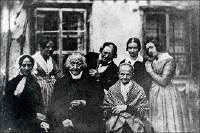Strange Coincidence: Titanic Disaster Foretold —
Status: True (kind of, though I wouldn't use the word 'foretold')
2spare.com offers a list of the
Top 15 Strangest Coincidences. It's an interesting list (Thanks for the link, Kathy!), and as far as I can tell all the coincidences they list are basically true. Or, at least, they've all been widely reported, and I haven't been able to find any false statements in them yet. (I didn't analyze all of them that closely.)
But one coincidence I found particularly interesting, that I hadn't read about before, involved an American writer named Morgan Robertson who in 1898 wrote a novella titled
Futility. It told the story of a massive ocean liner named the
Titan that hits an iceberg while crossing the Atlantic and sinks. Fourteen years later, in real life, the
Titanic hits an iceberg while crossing the Atlantic and sinks. Very weird.
The coincidence was definitely not lost on Robertson who immediately had his story republished after the
Titanic sank, with the new title
Futility and the Wreck of the Titan. Apparently he tweaked the republished story a little bit to make the similarities even more striking. (He altered the dimensions of his fictional boat to make it more like the
Titanic.) But the biggest similarity of all (
Titan vs.
Titanic) he didn't need to tweak. That was legitimately in the original story (which can be read
here).
This coincidence is discussed on
skepticwiki, which points out that the story is often used by believers in the paranormal as evidence of premonition. But as they point out:
"The most startling coincidence above all is the similarity in names between Titan and Titanic. In 2003, Senan Moloney wrote an article for the online resource Titanic Book Site where he finds three occasions before the writing of "Futility" where a ship named Titania sank at sea, and one of these bore certain similarities to the eventual Titanic disaster. It could be that, inspired by this disaster (or all three) Morgan Robertson chose to base his ocean liner's name on their names."
Still, it is a very striking coincidence. But sometimes strange coincidences do happen. That doesn't make them paranormal.
In fact, 2spare.com leaves off its list what I find to be the most amazing coincidence in history: that when the Pilgrims landed on Plymouth Rock in 1620, one of the first native Americans they met not only spoke fluent English, but had actually lived in England for a number of years and had crossed the Atlantic numerous times. (He was more cosmopolitan and well-traveled than they were.) To me this is just amazing that out of the entire huge continent the Pilgrims managed, by sheer luck, to find the one guy,
Squanto, who spoke English. It's like traveling halfway across the galaxy, landing on a planet, and discovering that the inhabitants speak English. (Of course, that happens in
Star Trek all the time.) And without Squanto's help the Plymouth Colony probably wouldn't have lasted through the winter, and American history itself might have taken a very different course. But it was just a coincidence. Nothing supernatural about it (though the Pilgrims definitely viewed it as an example of divine favor).

 A guy was out digging in an irish bog recently when, purely by chance, he found a book buried in the mud. Turns out that it could be a book of psalms over 1000 years old. Pat Wallace, director of the National Museum of Ireland, points out that this discovery was highly fortuitous:
A guy was out digging in an irish bog recently when, purely by chance, he found a book buried in the mud. Turns out that it could be a book of psalms over 1000 years old. Pat Wallace, director of the National Museum of Ireland, points out that this discovery was highly fortuitous:  Last week the London Times printed a photo that, so it claimed, was the only known photograph of Mozart's widow (Constanze), taken in 1840 at the home of Swiss composer Max Keller when she was 78 years old. (She's supposedly the woman on the far left.) However, the photo has generated controversy online, where a number of scholars have labeled it a hoax.
Last week the London Times printed a photo that, so it claimed, was the only known photograph of Mozart's widow (Constanze), taken in 1840 at the home of Swiss composer Max Keller when she was 78 years old. (She's supposedly the woman on the far left.) However, the photo has generated controversy online, where a number of scholars have labeled it a hoax.

 The discovery of massive pyramids in Bosnia was widely reported in the news last month (at which point Beasjt posted about it in the Hoax Forum). The discovery was made by a Bosnian-American businessman named Semir Osmanagic, who has been actively pursuing Chariots-of-the-Gods-style archaeology for the past fifteen years, mostly in Mexico and Central America. (He believes the Mayans were descended from Atlanteans who came from the Pleiades... you can read about it in his book, The World of the Maya, which is online.)
The discovery of massive pyramids in Bosnia was widely reported in the news last month (at which point Beasjt posted about it in the Hoax Forum). The discovery was made by a Bosnian-American businessman named Semir Osmanagic, who has been actively pursuing Chariots-of-the-Gods-style archaeology for the past fifteen years, mostly in Mexico and Central America. (He believes the Mayans were descended from Atlanteans who came from the Pleiades... you can read about it in his book, The World of the Maya, which is online.)  A resident of the town of Colfax (northern California) claims to have found hundreds of ancient Buddha figurines buried in the American River:
A resident of the town of Colfax (northern California) claims to have found hundreds of ancient Buddha figurines buried in the American River: The Raw Feed has linked to a video (in French) in which Belgian archaeologists discuss how they were able to "use computer scans of the grooves in 6,500-year-old pottery to extract sounds -- including talking and laughter -- made by the vibrations of the tools used to make the pottery." The video is fairly good quality and would lead you to believe that it might be real, if it weren't for the premise being pretty farfetched (and not reported anywhere else in the news). Make Magazine reports that the video was created last year as an April Fool's Day hoax, and point out that "This site - 'Poisson d'avril de journal televise', translates to: 'April fools newscast'." (However, I can't find any mention of Poisson d'avril in the site they link to.) Other Make readers point out that the premise (audio extracted from ancient pottery) was ripped off (pun intentional) from a story by Gregory Benford, Time Shards. (Thanks to Schmawy for the link)
The Raw Feed has linked to a video (in French) in which Belgian archaeologists discuss how they were able to "use computer scans of the grooves in 6,500-year-old pottery to extract sounds -- including talking and laughter -- made by the vibrations of the tools used to make the pottery." The video is fairly good quality and would lead you to believe that it might be real, if it weren't for the premise being pretty farfetched (and not reported anywhere else in the news). Make Magazine reports that the video was created last year as an April Fool's Day hoax, and point out that "This site - 'Poisson d'avril de journal televise', translates to: 'April fools newscast'." (However, I can't find any mention of Poisson d'avril in the site they link to.) Other Make readers point out that the premise (audio extracted from ancient pottery) was ripped off (pun intentional) from a story by Gregory Benford, Time Shards. (Thanks to Schmawy for the link)
 Forty years after stealing a "Sami Fleshscraper" from a Norwegian museum, the contrite thief has mailed the item back. Problem is, the museum has no idea what the object is. From the article on Yahoo News:
Forty years after stealing a "Sami Fleshscraper" from a Norwegian museum, the contrite thief has mailed the item back. Problem is, the museum has no idea what the object is. From the article on Yahoo News: Remember the Black Basketball League? Its teams (including favorites such as the Newark Eagles, Harlem Knights, Baltimore Crabs, West Philly Dancers and Cleveland Ebonies) competed from 1920-40, when they were shut out of the all-white league. Consumers can now honor the memory of this league by buying sportswear emblazoned with the team logos. Of course, if you don't remember this league, it might be because historians insist that it never existed. But Eric Williams, the guy who's selling the black league sportswear, isn't letting that minor fact bother him. He explains that:
Remember the Black Basketball League? Its teams (including favorites such as the Newark Eagles, Harlem Knights, Baltimore Crabs, West Philly Dancers and Cleveland Ebonies) competed from 1920-40, when they were shut out of the all-white league. Consumers can now honor the memory of this league by buying sportswear emblazoned with the team logos. Of course, if you don't remember this league, it might be because historians insist that it never existed. But Eric Williams, the guy who's selling the black league sportswear, isn't letting that minor fact bother him. He explains that:  A reporter for Inside Bay Area (I don't know his name... it's not given with the article) recently recounted how his granddaughter told him that the bear on the California flag was originally supposed to be a pear. Back in 1846, Capt. Jedediah Bartlett, leader of a band of rebels fighting against the Mexican authorities in California, supposedly drew up a flag for the future state. He thought a pear, as a symbol of the region's agriculture, would be a fitting symbol. But his instructions were misread and the flagmaker inserted a bear on the flag instead of a pear. The error was never rectified.
A reporter for Inside Bay Area (I don't know his name... it's not given with the article) recently recounted how his granddaughter told him that the bear on the California flag was originally supposed to be a pear. Back in 1846, Capt. Jedediah Bartlett, leader of a band of rebels fighting against the Mexican authorities in California, supposedly drew up a flag for the future state. He thought a pear, as a symbol of the region's agriculture, would be a fitting symbol. But his instructions were misread and the flagmaker inserted a bear on the flag instead of a pear. The error was never rectified.